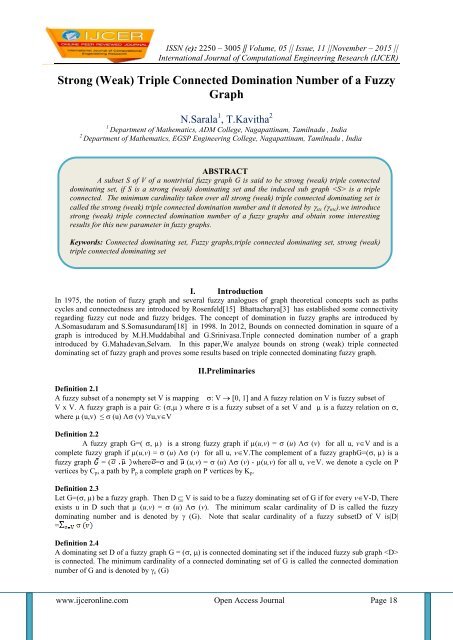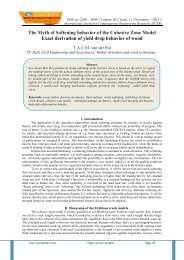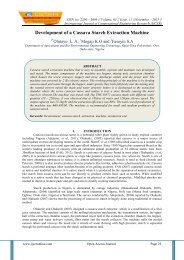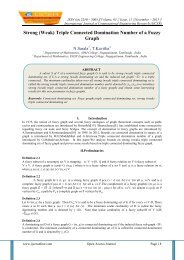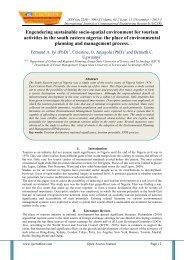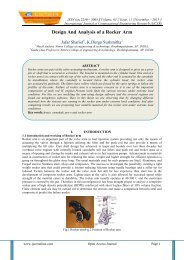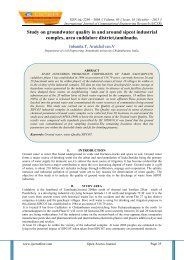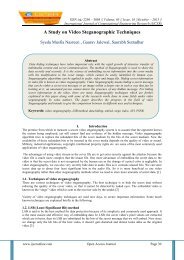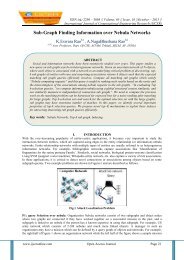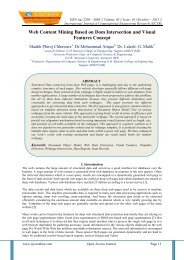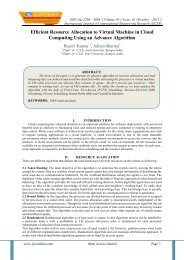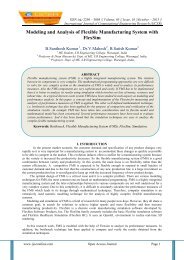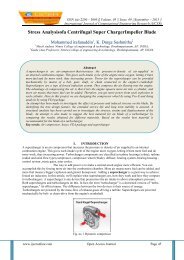Strong (Weak) Triple Connected Domination Number of a Fuzzy Graph
International Journal of Computational Engineering Research(IJCER) is an intentional online Journal in English monthly publishing journal. This Journal publish original research work that contributes significantly to further the scientific knowledge in engineering and Technology.
International Journal of Computational Engineering Research(IJCER) is an intentional online Journal in English monthly publishing journal. This Journal publish original research work that contributes significantly to further the scientific knowledge in engineering and Technology.
Create successful ePaper yourself
Turn your PDF publications into a flip-book with our unique Google optimized e-Paper software.
ISSN (e): 2250 – 3005 || Volume, 05 || Issue, 11 ||November – 2015 ||<br />
International Journal <strong>of</strong> Computational Engineering Research (IJCER)<br />
<strong>Strong</strong> (<strong>Weak</strong>) <strong>Triple</strong> <strong>Connected</strong> <strong>Domination</strong> <strong>Number</strong> <strong>of</strong> a <strong>Fuzzy</strong><br />
<strong>Graph</strong><br />
N.Sarala 1 , T.Kavitha 2<br />
1<br />
Department <strong>of</strong> Mathematics, ADM College, Nagapattinam, Tamilnadu , India<br />
2<br />
Department <strong>of</strong> Mathematics, EGSP Engineering College, Nagapattinam, Tamilnadu , India<br />
ABSTRACT<br />
A subset S <strong>of</strong> V <strong>of</strong> a nontrivial fuzzy graph G is said to be strong (weak) triple connected<br />
dominating set, if S is a strong (weak) dominating set and the induced sub graph is a triple<br />
connected. The minimum cardinality taken over all strong (weak) triple connected dominating set is<br />
called the strong (weak) triple connected domination number and it denoted by stc ( wtc ).we introduce<br />
strong (weak) triple connected domination number <strong>of</strong> a fuzzy graphs and obtain some interesting<br />
results for this new parameter in fuzzy graphs.<br />
Keywords: <strong>Connected</strong> dominating set, <strong>Fuzzy</strong> graphs,triple connected dominating set, strong (weak)<br />
triple connected dominating set<br />
I. Introduction<br />
In 1975, the notion <strong>of</strong> fuzzy graph and several fuzzy analogues <strong>of</strong> graph theoretical concepts such as paths<br />
cycles and connectedness are introduced by Rosenfeld[15] Bhattacharya[3] has established some connectivity<br />
regarding fuzzy cut node and fuzzy bridges. The concept <strong>of</strong> domination in fuzzy graphs are introduced by<br />
A.Somasudaram and S.Somasundaram[18] in 1998. In 2012, Bounds on connected domination in square <strong>of</strong> a<br />
graph is introduced by M.H.Muddabihal and G.Srinivasa.<strong>Triple</strong> connected domination number <strong>of</strong> a graph<br />
introduced by G.Mahadevan,Selvam. In this paper,We analyze bounds on strong (weak) triple connected<br />
dominating set <strong>of</strong> fuzzy graph and proves some results based on triple connected dominating fuzzy graph.<br />
II.Preliminaries<br />
Definition 2.1<br />
A fuzzy subset <strong>of</strong> a nonempty set V is mapping : V[0, 1] and A fuzzy relation on V is fuzzy subset <strong>of</strong><br />
V x V. A fuzzy graph is a pair G: (, ) where is a fuzzy subset <strong>of</strong> a set V and is a fuzzy relation on ,<br />
where (u,v) ≤ (u) (v) u,vV<br />
Definition 2.2<br />
A fuzzy graph G=( , µ) is a strong fuzzy graph if µ(u,v) = (u) (v) for all u, vV and is a<br />
complete fuzzy graph if µ(u,v) = (u) (v) for all u, vV.The complement <strong>of</strong> a fuzzy graphG=(, µ) is a<br />
fuzzy graph = ( where = and (u,v) = (u) (v) - µ(u,v) for all u, vV. we denote a cycle on P<br />
vertices by C p , a path by P p a complete graph on P vertices by K p .<br />
Definition 2.3<br />
Let G=(, µ) be a fuzzy graph. Then D V is said to be a fuzzy dominating set <strong>of</strong> G if for every vV-D, There<br />
exists u in D such that µ (u,v) = (u) (v). The minimum scalar cardinality <strong>of</strong> D is called the fuzzy<br />
dominating number and is denoted by (G). Note that scalar cardinality <strong>of</strong> a fuzzy subsetD <strong>of</strong> V isD<br />
=<br />
Definition 2.4<br />
A dominating set D <strong>of</strong> a fuzzy graph G = (, ) is connected dominating set if the induced fuzzy sub graph <br />
is connected. The minimum cardinality <strong>of</strong> a connected dominating set <strong>of</strong> G is called the connected domination<br />
number <strong>of</strong> G and is denoted by c (G)<br />
www.ijceronline.com Open Access Journal Page 18
<strong>Strong</strong> (<strong>Weak</strong>) <strong>Triple</strong> <strong>Connected</strong> <strong>Domination</strong>…<br />
Definition 2.5<br />
Let G be a fuzzy graph the neighborhood <strong>of</strong> a vertex v in V is defined by N(v) ={uV:µ (u,v) = (u) <br />
(v)}.The scalar cardinality <strong>of</strong> N(V) is the neighborhood degree <strong>of</strong> V, Which is denoted by d N(V) and the effective<br />
degree <strong>of</strong> V is the sum <strong>of</strong> the weights <strong>of</strong> the edges incident on V denoted by d E(v)<br />
Definition2.6<br />
Let u and v be any two vertices <strong>of</strong> a fuzzy graph G. Then u strongly dominates v(v weakly dominates u) if<br />
i) µ (u,v) = (u) (v). and<br />
ii) d N(u) >d N(v)<br />
Definition2.7<br />
Let G be a fuzzy graph, then D V is said to be a strong(weak) fuzzy dominating set <strong>of</strong> G if every vertex vV-<br />
D is strongly (weakly) dominated by some vertex u in D. We denoted a strong (weak) fuzzy dominating set by<br />
sfd -set(wfd-set).<br />
The minimum scalar cardinality <strong>of</strong> a sfd-set(wfd-set) is called the strong (weak) fuzzy domination<br />
number <strong>of</strong> G and it is denoted by sd (G) ( wd (G))<br />
h(0.4)<br />
g(0.3)<br />
a<br />
(0.2)<br />
Fig:2<br />
b<br />
(0.1)<br />
f(0.2)<br />
c<br />
(0.1)<br />
e(0.5)<br />
d(0.3)<br />
Example2.8<br />
For the fuzzy graph G in Fig.2. sd (G) =0.8 and wd (G)=1.0.since {a,b,e} and {c,f,g,h} are the minimum sfd-set<br />
and wfd-set respectively.<br />
Theorem 2.9<br />
Let D be a minimal sfd- set <strong>of</strong> a fuzzy graph G. Then for each uD <strong>of</strong> the following holds.<br />
(i) No vertex in D strongly dominate v<br />
(ii) There exists v V-D such that v is the only vertex in D which strongly dominates u.<br />
Pro<strong>of</strong><br />
Suppose D is a minimal connected dominating set <strong>of</strong> G. Then for each node uD the set D=D-{u} is<br />
not a connected dominating set. Thus, there is a node vV-D which is not dominated by any node in D. Now<br />
either u=v or vV-D, If v=u then no vertex in D strongly dominates v. If vV-D and v is not dominated by D-<br />
{u} but is dominated by D, Then u is the only strong neighbor <strong>of</strong> v and v is the only vertex in D which strongly<br />
dominates u.<br />
Conversely suppose D is a dominating set and each node uD, one <strong>of</strong> the two stated conditions holds. Now we<br />
prove D is a minimal strong connected dominating set. Suppose D is not a minimal strong connected<br />
dominating set, then there exists a node uD such that D-{u} is a dominating set. Therefore condition (i) does<br />
not hold. Also if D-{u} is a dominating set then every node in V-D is a strong neighbor to at least one node in<br />
www.ijceronline.com Open Access Journal Page 19
<strong>Strong</strong> (<strong>Weak</strong>) <strong>Triple</strong> <strong>Connected</strong> <strong>Domination</strong>…<br />
D-{u}. Therefore condition (ii) does not hold. Hence neither condition (i) nor (ii) holds which is a<br />
contradiction.<br />
Definition2.10<br />
A fuzzy graph G is said to be triple connected if any three vertices lie on a path in G. All paths, cycles, complete<br />
graphs are some standard examples <strong>of</strong> triple connected fuzzy graphs.<br />
Definition2.11<br />
A subset D <strong>of</strong> V <strong>of</strong> a nontrivial connected fuzzy graph G is said to be triple connected dominating set. If D is<br />
the dominating set and the induced fuzzy sub graph is triple connected .The minimum cardinality taken<br />
over all triple connected dominating set <strong>of</strong> G is called the triple connected dominating number <strong>of</strong> G and is<br />
denoted by tc (G).<br />
Example 2.12<br />
For the fuzzy graph Fig.3, D = {v 1 ,v 2 ,v 5 } forms a tc set <strong>of</strong> G<br />
Fig.3, tc (G) =0.8+0.5+0.6 =1.9<br />
III.<strong>Strong</strong> (weak) <strong>Triple</strong> connected domination number <strong>of</strong> a fuzzy graph<br />
Definition3.1<br />
A subset S <strong>of</strong> V <strong>of</strong> a nontrivial fuzzy graph G is said to be strong (weak) triple connected dominating set, if S is<br />
a strong (weak) dominating set and the induced sub graph is a triple connected. The minimum cardinality<br />
taken over all strong (weak) triple connected dominating set is called the strong (weak) triple connected<br />
domination number and it denoted by stc ( wtc ). In this section we present few elementary bounds on<br />
strong(weak) triple connected domination number <strong>of</strong> a fuzzy graph and the correspondingsome results<br />
Fig:4<br />
Example3.2For the fuzzy graph in Fig : 4, s = {v 1 ,v 2 ,v 6 } forms stc set and w = {v 3 ,v 4 ,v 5 } forms wtc set.<br />
stc (G) = 0.6 and wtc (G) = 1<br />
Theorem3.3<br />
<strong>Strong</strong> (weak) triple connected dominating set does not exists for all fuzzy graphs.<br />
Pro<strong>of</strong> By definition,The connected graph is not strong (weak) triple connected.consider only connected fuzzy<br />
graphs for which strong (weak) triple connected dominating set exists.<br />
Observation 3.4 Every strong (weak) triple connected dominating set is a dominating set but not conversely.<br />
Observation 3.5 Every strong (weak) triple connected dominating set is a triple connected dominating set but<br />
not conversely.<br />
Observation 3.6 The complement <strong>of</strong> strong (weak) triple connected dominating set need not be a strong (weak)<br />
triple connected dominating set.<br />
www.ijceronline.com Open Access Journal Page 20
<strong>Strong</strong> (<strong>Weak</strong>) <strong>Triple</strong> <strong>Connected</strong> <strong>Domination</strong>…<br />
Theorem3.7 For a fuzzy graph G <strong>of</strong> order p, (i) (G) ≤ sd (G) ≤ stc (G) P-Δ N (G) ≤ p-Δ E (G) and<br />
(ii) (G) ≤ wd (G) ≤ wtc (G) ≤ P-δ N (G) ≤ p-δ E (G) where Δ N (G) [Δ E (G)] and δ N (G) [δ E (G)] denote the maximum<br />
and minimum neighborhood degrees (effective degrees )<strong>of</strong> G<br />
Pro<strong>of</strong> Since every stcd set (wtcd) is a fuzzy dominating set <strong>of</strong> G, (G) ≤ sd (G) ≤ stc (G) and<br />
(G) ≤ wd (G) ≤ wtc (G).Let u ,vV, If d N(u) = Δ N (G) and d N(v) = δ N (G).Then clearly V-N(u) is a stcd- set and V-<br />
N(v) is a wtcd -set. Therefore stc (G)≤V-N(u) and wtc (G)≤V-N(u) that is stc (G) ≤ P-Δ N (G) and<br />
wtc (G) ≤ P-δ N (G) Further since Δ E (G)] ≤ Δ N (G)and δ E (G)≤ δ N (G)<br />
Hence (G) ≤ sd (G) ≤ stc (G) ≤ P-Δ N (G) ≤ p-Δ E (G) and<br />
(G) ≤ wd (G) ≤ wtc (G) ≤ P-δ N (G) ≤ p-δ E (G)<br />
Theorem3.8 For any connected fuzzy graph G, (G) ≤ c (G) ≤ tc (G) ≤ stc (G) ≤ wtc (G).<br />
Pro<strong>of</strong> Let G be a fuzzy graph and D be a minimum dominating set. D tc is triple connected dominating set but<br />
need not be a minimum fuzzy dominating set, and alsoD stc is a strong (weak) triple connected dominating set.<br />
Therefore we getD ≤D c ≤D tc ≤D st andD stc ≤D wtc <br />
That is (G) ≤ c (G) ≤ tc (G) ≤ stc (G) ≤ wtc (G).<br />
Theorem 3.9 If a spanning sub graph H <strong>of</strong> a graph G has a strong(weak) triple connected dominating set then G<br />
also has a strong (weak) triple connected dominating set.<br />
Pro<strong>of</strong> Let G be a connected fuzzy graph and H is the spanning sub graph <strong>of</strong> G. H has a strong (weak) triple<br />
connected dominating set and V(G) = V(H) therefore G is a strong (weak) triple connected dominating set.<br />
Theorem 3.10 For any connected fuzzy graph G with P vertices and strong (weak) triple connected dominating<br />
vertices P if any only if G P 3 or C 3 .<br />
Pro<strong>of</strong> Suppose GP 3 , C 3 then the strong(weak) triple connected dominating vertices is 3, and P vertices.<br />
Conversely, Let G be a connected fuzzy graph with P vertices such that strong (weak) triple connected<br />
dominating vertices P then<br />
G P 3 or C 3<br />
Theorem 3.11 For any connected fuzzy graph G with P3 vertices and exactly one vertex hasΔ N (G) ≤P-2, the<br />
strong triple connected dominating vertices is 3.<br />
Pro<strong>of</strong> Let G be a connected graph with P3 vertices and exactly one vertex has maximum neighborhood degree<br />
Δ N (G) ≤P-2.Let v be the vertex <strong>of</strong> maximum neighborhood degree Δ N (G) ≤P-2. Let v 1 ,v 2 …… and v p-2 be the<br />
vertices which are adjacent to v and Let v p-1 be the vertex which is not adjacent to v. Since G is connected, v p-1<br />
is adjacent to a vertex v i for some i, Then s = {v,v i ,v p-1 } forms a minimum strong triple connected dominating<br />
set <strong>of</strong> G.<br />
Theorem 3.12 For a connected fuzzy graph G with 5 vertices, the strong triple connected dominating vertices is<br />
P-2 if and only if G is isomorphic to P 5 ,C 5 .<br />
Pro<strong>of</strong> Suppose G is isomorphic to P 5 ,C 5 then clearly strong triple connected dominating vertices is P-2<br />
conversely, let G be a connected fuzzy graph with 5 vertices and strong triple connected dominating vertices<br />
is 3. Let S={ v 1 ,v 2 ,v 3 } be a stc set then clearly = P 3 or C 3 . Let V-S= V(G)-V(S)= { v 4 ,v 5 } then<br />
{V-S} =K 2 or k<br />
2<br />
Case (i) = P 3 = v 1 v 2 v 3<br />
Sub case (i) = K 2 = v 4 v 5<br />
Since G is connected, there exists a vertex say v 1 (or v 3 ) in P 3 which is adjacent to v 4 (or v 5 ) in K 2 , then s={v 1 ,<br />
v 2 , v 4 } forms stc set <strong>of</strong> G so that strong triple connected dominating vertices is P-2. If v 4 is adjacent to v 1 , if the<br />
vertices v 1 and v 2 are connected to two vertices, v 3 is connected to one vertex then G is isomorphic to P 5 . Since<br />
G is connected there exists a vertex say v 2 in P 3 is adjacent to v 4 (or v 5 ) in K 2 . Then S={ v 2, v 4, v 5 } forms a stc<br />
set <strong>of</strong> G so that strong triple connected dominating vertices is P-2. If the vertex v 1 and v 3 are connected to two<br />
vertices and v 2 is connected to one vertex. Then G is isomorphic to P 4 . Now by increasing the degree <strong>of</strong> the<br />
vertices by the above arguments, we have GC 5<br />
subcase (ii) = k .<br />
2<br />
Since G is connected, then there exists a vertex say v 1 ( or v 3 ) in P 3 is adjacent to v 4 and v 5 in k . Then<br />
2<br />
S={ v 1 ,v 2 ,v 3 } forms a stc set <strong>of</strong> G so that strong triple connected dominating vertices is P-2. Since G is<br />
connected. There exists a vertex say v 2 in P 3 which is adjacent to v 4 and v 5 in k . Then S={ v<br />
2<br />
1 ,v 2 ,v 3 } forms a<br />
stc set <strong>of</strong> G so that strong triple connected dominating vertices is P-2.since G is connected, there exists a vertex<br />
say v 1 in P 3 which is adjacent v 2 in<br />
2<br />
k and v 3 in P 3 is adjacent to v 5 in K 2 . Then S={ v 1 ,v 2 ,v 3 } form a stc set<br />
<strong>of</strong> G so that strong triple connected dominating vertices is P-2. Since G is connected, then there exists a vertex<br />
www.ijceronline.com Open Access Journal Page 21
<strong>Strong</strong> (<strong>Weak</strong>) <strong>Triple</strong> <strong>Connected</strong> <strong>Domination</strong>…<br />
say v 1 in P 3 is adjacent to v 4 in k 2<br />
and v 3 in P 3 is adjacent to v 5 in k . Then S={ v<br />
2<br />
1 ,v 2 ,v 3 } forms a stc set <strong>of</strong> G<br />
so that strong triple connected dominating vertices is P-2<br />
Case (ii) = C 3 = v 1 v 2 v 3 v 1<br />
Sub case (i)= K 2 = v 4 v 5<br />
Since G is connected, there exists a vertex say v 1 , (or v 2 ,v 3 ) in C 3 is adjacent to v 4 (or v 5 ). Then S={ v 1 ,v 2 ,v 4 }<br />
forms a stc set <strong>of</strong> G so that strong triple connected dominating vertices is P-2. If the vertex v 1 , v 2 , and v 3 are<br />
connected to two vertices than G C3<br />
Sub case (ii) = K 2<br />
Since G is connected there exists a vertex say v 1 ( or v 2 ,v 3 ) in C 3 is adjacent to v 4 in k<br />
2<br />
C 3 is adjacent to v 5 in k<br />
2<br />
vertices is P-2.<br />
and v 2 (or v 3 ) in<br />
. Then S={ v 1 ,v 2 ,v 3 } forms a stc set <strong>of</strong> G so that strong triple connected dominating<br />
IV. Conclusion<br />
The strong (weak) triple connected domination number <strong>of</strong> fuzzy a graph is defined. Theorems related to<br />
this concept are derived and the relation between triple connected domination number <strong>of</strong> fuzzy graphs and<br />
strong (weak) triple connected domination number <strong>of</strong> fuzzy graphs are established.<br />
References<br />
[1] AntonyXaviorD,FlorenceIsido D, Chitra V.M., On <strong>Domination</strong> in <strong>Fuzzy</strong> graph,Inter.journal <strong>of</strong> com.Algorithm vol 02(2013),<br />
248-250.<br />
[2] Bhutani K.R, <strong>Strong</strong> arc in <strong>Fuzzy</strong> graphs, Information science,152(1989),319-322.<br />
[3] Bhattacharya, Some remarks on fuzzy <strong>Graph</strong>s,PatterRecognition letter 6(1987), 297-302.<br />
[4] HararyF (1972),<strong>Graph</strong> Theory,Adisen-wesley Reading mass.<br />
[5] Haynes T.W.,Headetniemi S.T., Slater P.J, Fundanmental <strong>Domination</strong> in <strong>Graph</strong>,MarcelDekkeel,Newyork<br />
[6] Laura A.sanchis,On the number <strong>of</strong> edges in graph with a given connected domination number,Elsevier,Discrete Mathematics<br />
214(2000) ,193-210.<br />
[7] Moderson N. and Nair P.S., <strong>Fuzzy</strong> graphs and <strong>Fuzzy</strong> Hyper graphs, Physicaverlag(2000).<br />
[8] Muddebihal M.H., SrinivasaG, Bounds connected domination in squares <strong>of</strong> graph ,Inter.Jour.sci. andTech.vol<br />
1.No.4(2012),170-175<br />
[9] Mahadevan G.,Selvam. <strong>Triple</strong> connected complementary Tree domination number <strong>of</strong> a graph. International Mathematics<br />
Forum,Vol.8,2013,no.14,659-670<br />
[10]. MahadevanG,Selvam. <strong>Triple</strong> connected domination number <strong>of</strong> a graph. International Mathematics Combin,Vol.3,2012,93-104<br />
[11] MahadevanG,Selvam,BhagavathyAmmal, Avadayappan,Subramanian.T, <strong>Strong</strong> <strong>Triple</strong> connected domination number <strong>of</strong> a<br />
graph. IJCER Vol.3(2013) 242-247<br />
[12] MahadevanG,Selvam,BhagavathyAmmal, Avadayappan,Subramanian.T<strong>Weak</strong> <strong>Triple</strong> connected domination number <strong>of</strong> a graph.<br />
IJMER Vol.3(2013) 342-345<br />
[13] NagorGaniA.andchandrasekaran V.T, <strong>Domination</strong> in <strong>Fuzzy</strong> graph, Advances in <strong>Fuzzy</strong> sets and system1 (1)(2006), 17-26.<br />
[14] Natrajan.C,AyyaswamyS.K, On strong (weak) domination in fuzzy graph, World academy <strong>of</strong> sci.Engineering Technology Vol<br />
43(2010)526-528<br />
[15] RosenfeldLA..ZedehA,FuK.S.Tanaka .K.,M.Shimura(Eds) ,<strong>Fuzzy</strong> sets and their Application to cogenitive and Decision<br />
Processes, Academic press, Newyork (1975) ,77-95<br />
[16] Sarala.N,kavitha,T.,<strong>Triple</strong> connected domination number <strong>of</strong> fuzzy graph, International Journal <strong>of</strong> Applied Engineering Research,<br />
Vol. 10 No.51 (2015)914-917<br />
[17] Sarala.N, kavitha, T.,<strong>Connected</strong> <strong>Domination</strong> <strong>Number</strong> <strong>of</strong> Square <strong>Fuzzy</strong> <strong>Graph</strong>,IOSR-JM, Volume 10, Issue 6 Vel III ( 2014),<br />
12-15.<br />
[18] Somasundaram.A.and.Somasundaram .S,<strong>Domination</strong>in<strong>Fuzzy</strong> graph-I.,Pattern Recognitionletter19(9) (1998)77-95.<br />
www.ijceronline.com Open Access Journal Page 22


